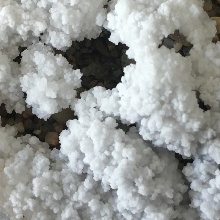Research within the vision topic
Motivation
Understanding evaporation of water in porous media in the presence of soluble salts plays a key role in many environmental and hydraulic applications, such as water management, the global water cycle, plant growth, plant yield and vegetation, agriculture, rock weathering, soil and groundwater salinization, as well as in other fields such as the construction of porous building materials. In many arid and semi-arid regions, evaporation from porous media induces salt deposition and crystallization on the surface or within the porous matrix, resulting in the degradation of soil productivity. This problem concerns a wide range of soils worldwide, for example in Tunisia, where the salt-affected soils make up more than 10% of the entire country’s surface; hence, the understanding of such phenomena is of great importance.
Research questions
Results from SFB 1313's first funding period have shown that accurately modelling evaporation of saline water from porous media in the presence of salt precipitation remains challenging. This is attributed to the complexity of salt precipitation that can range from efflorescent crusts at the top of the soil (e.g. NaCl) to subflorescent precipitation within the porous medium (e.g. MgSO4). It is evident in experiments that these salt crusts formed on top of the soil have their own porous structure that allows evaporation, which makes modelling these crusts all the more challenging. In addition, the formation of salt crusts can be prevented when density-driven instabilities lead to a convective transport of saline water accumulated at the top towards deeper soil layers. However, the conditions that lead to that phenomenon are still poorly investigated.
With Project Area A of SFB 1313 focussed on coupled free-flow porous-medium processes and Project Area C focussed on fluild-solid phase change, a combination of researchers of both project areas form a well fitted team to answer the following research question:
- Salt precipitation vs. convective mixing: When does salt precipitation occur and under what conditions is mixing due to density-driven instabilities the dominant process?
- Evaporation influenced by salt crust: Salt crusts have a porous structure of their own and therefore can change evaporation processes, e.g. due to changes in capillary forces leading to a higher water transport towards the top of the soil. However, salt precipitation can also block pathways and decrease evaporation. How does the formation of salt crusts influence evaporation and how can that be accurately incorporated in numerical models?
- Salt precipitation and root water uptake: The formation of salt crusts and high salinity in soils hinders root water uptake and with that plant growth and crop yield. A future research question therefore will investigate how root water uptake is affected and how the transport of water towards roots changes in saline soils.
Solution strategy
One main research goal of SFB 1313 is to be able to analyse and understand systems where the behaviour of systems is governed by the character, geometry, and dynamics of different types of fluid-fluid and fluid-solid interfaces that occur not only on the targeted application scale, but especially on smaller scales. For such a system, soil salinization is a good example. While being able to model larger soil systems on the REV scale is needed to be able to describe e.g. effects of soil crusts on plant growth, relevant processes occur on smaller scales.
This is why SFB 1313 plans a scale dependent solution strategy where processes on the molecular scale are investigated, integrated into the pore scale and then upscaled onto the REV scale.
Involved researchers
Strategy
Several projects within SFB 1313 have dedicated work packages for the vision topic salt precipitation. Additionally, associated researchers, closely related to the work of SFB 1313 but not financed by SFB 1313, complete the team working on the vision topic.
Involved projects
Publications concerning the vision topic
Preprints
- Bringedal, C., Kiemle, S., van Duijn, C. J., & Helmig, R. (2025). Impact of saturation on evaporation-driven density instabilities in porous media: mathematical and numerical analysis. In arXiv preprint arXiv:2501.12784. https://doi.org/10.48550/arXiv.2501.12784
- Chaudhry, M. A., Kiemle, S., Pohlmeier, A., Helmig, R., & Huisman, J. A. (2025). Non-invasive imaging of solute redistribution below evaporating surfaces using 23Na-MRI. In arXiv preprint arXiv:2504.00216. https://doi.org/10.48550/arXiv.2504.00216
- Schollenberger, T., Rohde, C., & Helmig, R. (2025). Two-phase pore-network model for evaporation-driven salt precipitation - representation and analysis of pore-scale processes. In arXiv preprint arXiv:2503.22533. https://doi.org/10.48550/arXiv.2503.22533
Conference Papers
- Jabbari, M., Jambhekar, V. A., Gersborg, A. R., Spangenberg, J., Hattel, J. H., & Helmig, R. (2016). Numerical modelling of the flow in the resin infusion process on the REV scale: A feasibility study. AIP Conference Proceedings. https://doi.org/10.1063/1.4951807
Journal Articles
- Jannesarahmadi, S., Aminzadeh, M., Helmig, R., Or, D., & Shokri, N. (2024). Quantifying Salt Crystallization Impact on Evaporation Dynamics From Porous Surfaces. Geophysical Research Letters, 51, Article 22. https://doi.org/10.1029/2024gl111080
- Schollenberger, T., von Wolff, L., Bringedal, C., Pop, I. S., Rohde, C., & Helmig, R. (2024). Investigation of Different Throat Concepts for Precipitation Processes in Saturated Pore-Network Models. Transport in Porous Media, 151, Article 14. https://doi.org/10.1007/s11242-024-02125-5
- Kiemle, S., Heck, K., Coltman, E., & Helmig, R. (2023). Stable Water Isotopologue Fractionation During Soil-Water Evaporation: Analysis Using a Coupled Soil-Atmosphere Model. Water Resources Research, 59, Article 2. https://doi.org/10.1029/2022wr032385
- Bringedal, C., Schollenberger, T., Pieters, G. J. M., van Duijn, C. J., & Helmig, R. (2022). Evaporation-Driven Density Instabilities in Saturated Porous Media. Transport in Porous Media, 143, Article 2. https://doi.org/10.1007/s11242-022-01772-w
- Mejri, E., Helmig, R., & Bouhlila, R. (2020). Modeling of Evaporation-Driven Multiple Salt Precipitation in Porous Media with a Real Field Application. Geosciences, 10, Article 10. https://doi.org/10.3390/geosciences10100395
- Shokri-Kuehni, S. M. S., Raaijmakers, B., Kurz, T., Or, D., Helmig, R., & Shokri, N. (2020). Water Table Depth and Soil Salinization: From Pore-Scale Processes to Field-Scale Responses. Water Resources Research, 56, Article 2. https://doi.org/10.1029/2019wr026707
- Jabbari, M., Nasirabadi, P. S., Jambhekar, V. A., Hattel, J. H., & Helmig, R. (2017). Drying of a tape-cast layer: Numerical investigation of influencing parameters. International Journal of Heat and Mass Transfer, 108, 2229–2238. https://doi.org/10.1016/j.ijheatmasstransfer.2017.01.074
- Mejri, E., Bouhlila, R., & Helmig, R. (2017). Heterogeneity Effects on Evaporation-Induced Halite and Gypsum Co-precipitation in Porous Media. Transport in Porous Media, 118, Article 1. https://doi.org/10.1007/s11242-017-0846-8
- Jabbari, M., Jambhekar, V. A., Hattel, J. H., & Helmig, R. (2016). Drying of a tape-cast layer: Numerical modelling of the evaporation process in a graded/layered material. International Journal of Heat and Mass Transfer, 103, 1144–1154. https://doi.org/10.1016/j.ijheatmasstransfer.2016.08.073
- Jambhekar, V. A., Mejri, E., Schröder, N., Helmig, R., & Shokri, N. (2016). Kinetic Approach to Model Reactive Transport and Mixed Salt Precipitation in a Coupled Free-Flow-Porous-Media System. Transport in Porous Media, 114, Article 2. https://doi.org/10.1007/s11242-016-0665-3
- Jambhekar, V. A., Helmig, R., Schröder, N., & Shokri, N. (2015). Free-Flow-Porous-Media Coupling for Evaporation-Driven Transport and Precipitation of Salt in Soil. Transport in Porous Media, 110, Article 2. https://doi.org/10.1007/s11242-015-0516-7
Contact

Rainer Helmig
Prof. Dr.-Ing. Dr.-Ing. h.c.Project Leader, Former Spokesperson, Research Projects A02, A05, and C02




